Parco Archeominerario di San Silvestro
Archaeological Mining Park of San Silvestro
Useful Information
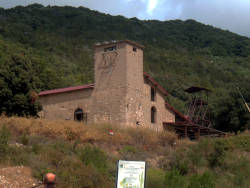
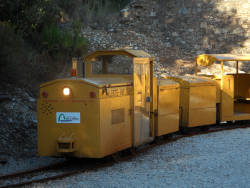
| Location: |
loc. Temperino, Via di San Vincenzo 34/b, Campiglia Marittima.
(43.083989, 10.605757) |
| Open: |
See online ticket system. Post-pandemic Aftermath Post-pandemic Aftermath[2022] |
| Fee: |
Adults EUR 25, Children (6-14) EUR 20, Seniors (65+) EUR 20, Family (2+3) EUR 60. Groups (20+): Adults EUR 13. [2022] |
| Classification: |
 Copper Mine Copper Mine
 Lead Mine Lead Mine
 Silver Mine Silver Mine
 Zinc Mine Zinc Mine
 Limestone Mine Limestone Mine
|
| Light: |
 Electric Light Electric Light
|
| Dimension: | |
| Guided tours: |
Complete visit of the Park: D=6 h. Temperino Mine: D=40 min, L=360 m, T=14 °C. Lanzi-Temperino Tunnel: D=40 min, T=14 °C. |
| Photography: | allowed |
| Accessibility: | partly |
| Bibliography: | |
| Address: |
Parco Archeominerario di San Silvestro, loc. Temperino, Via di San Vincenzo 34/b, Campiglia Marittima, Tel: 0565-838680, Tel: 0565-226445, Fax: 0585-838703, Fax: 0565-226521.
E-mail: |
| As far as we know this information was accurate when it was published (see years in brackets), but may have changed since then. Please check rates and details directly with the companies in question if you need more recent info. |
|
History
| 7th century B.C. | beginning of mining activities. |
| 1976 | Temperino Mine closed during the mining crisis. |
| 06-JUL-1996 | park inaugurated. |
Geology
Description
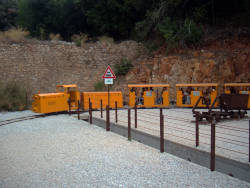
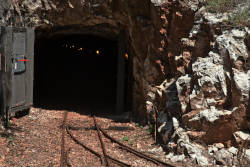
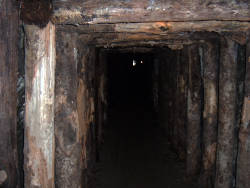
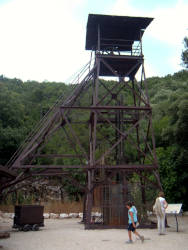
Parco Archeominerario di San Silvestro (San Silvestro Archaeological Mines Park) covers 450 ha of hills north of Campiglia Marittima. It is one of the six parks managed by Parchi Val di Cornia S.p.A.. The park is named after Rocca San Silvestro, a Medieval village opposite the mining museum. It first belonged to the Della Gherardesca family, and later during the 12th and 13th century it belonged to the Della Rocca family. The town was abandoned in the 14th century, today its ruins are part of the park.
Mining in this area started during the 7th century BC by the Etruscans. The Temperino Mine was mined from the Etruscan period to the 1970s. Today the entrance buildings contain two different museums. The Museo dell’Archeologia e dei Minerali (Mineralogical and Archaeological Museum) shows a broad collection of minerals from the Campiglia Marittima. They were collected between 1995 and 1996 for the opening of the park. The geology section also explains the formation of the mineral deposits at Campiglia. Between 1984 and 1992 the Rocca San Silvestro was excavated, the findings are also shown in this museum, in the archaeological section. Everyday objects, work tools and copper and silver coins from the Middle Ages are on display. The Museo dei Minatori (Miners’ Museum) displays the work and the daily life of the miners, the typical miners diseases and the struggles of the trade union during the 1970s. It is located in the Morteo, a metal “hut” used by the miners as changing room and canteen. The exhibition consists mostly of photographs and documents, and there is a video shown.
Nearby is a third museum, the Museo delle Macchine Minerarie (Museum of Mining Machinery) with heavy machinery. Located in the service building of Pozzo Earle, the main mine shaft of the Archaeological Mines Park of San Silvestro, it includes the winch room, the traction unit for the cages. It transported minerals and miners between the six levels of the 200 m deep mine. It was operated from the mid 19th century until the 1980s. On display are also jackhammers to drill the rocks, compressors, the rock cores extracted during drilling operations, and tractors and wagons to transport the minerals.
And finally there is the art gallery Galleria Lanzi-Temperino, an open air art gallery in the former flotation plants, exhibiting the photos of Giovanni Breschi and the sculptures of Dario Bartolini. The sculptures can actually be found all over the park.
There is an underground tour through the Temperino Mine, which was mined for copper, lead, silver and zinc. Visitors are equipped with helmets. The 360 m long tunnel was started by a French mining company in the mid 19th century, and it was completed in the 1860s. It shows the rather modern mining technology of the 19th century. Finally, the Etruscan mines are reached, showing the ancient mining techniques. There is some walking through underground mine tunnels, where the mining tools and the ores can be seen.
The second underground tour is a ride on a mine train through the Lanzi-Temperino Tunnel. This tunnel was started in the late 19th century for prospecting. In the 1960s it was completed by the Società italiana Miniera di Campiglia Spa. The narrow gauge railway line was used to transport the ores to the Valle Lanzi crushing and flotation plants. So this tour shows the most modern part of the mine, the vast chambers of the 20th century mining. The tour ends at the mouth of a limestone quarry which is still operating. The mining machinery from the closed lead and copper mines was converted for the crushing of the limestone.
The tours are offered for individual tourists, groups can book special tours with certain topics, for example experimental archeology, environmental education workshops, or animated visits. The site is closed during winter, except for school holidays, and open during summer, but the schedule is now actually in the online booking system, a result of the Corona pandemic. Online booking was one of the government measures, and it seems they kept it that way afterwards. However, it’s possible to book until 2 hours before the tour, if you have a smartphone and there are still open places. Groups must make a reservation by email. Start your visit at the ticket office in the Mineralogical and Archaeological Museum, which also offers further information.
The visit of the park with all sites takes at least half a day, you should allow about 6 hours. So while the entrance fee is quite steep, its nevertheless good value and includes a ride on the mining train. It’s also possible to visit only certain sites, however, the number of combinations is confusing. We strongly recommend to plan a full day and visit all sites. There are also some quite interesting trails if the weather is suitable.
- See also
 Search DuckDuckGo for "Parco Archeominerario di San Silvestro"
Search DuckDuckGo for "Parco Archeominerario di San Silvestro" Google Earth Placemark
Google Earth Placemark Parco Archeominerario di San Silvestro - Wikipedia (visited: 23-OCT-2010)
Parco Archeominerario di San Silvestro - Wikipedia (visited: 23-OCT-2010) Archaeological mines park of San Silvestro, official website (visited: 06-DEC-2022)
Archaeological mines park of San Silvestro, official website (visited: 06-DEC-2022) Parco archeominerario di San Silvestro
Parco archeominerario di San Silvestro  (visited: 06-DEC-2022)
(visited: 06-DEC-2022) San Silvestro Archaeological Mines Park (visited: 06-DEC-2022)
San Silvestro Archaeological Mines Park (visited: 06-DEC-2022) Parco Archeominerario di San Silvestro [San Silvestro Archaeological Mines Park] (visited: 06-DEC-2022)
Parco Archeominerario di San Silvestro [San Silvestro Archaeological Mines Park] (visited: 06-DEC-2022)
 Index
Index Topics
Topics Hierarchical
Hierarchical Countries
Countries Maps
Maps